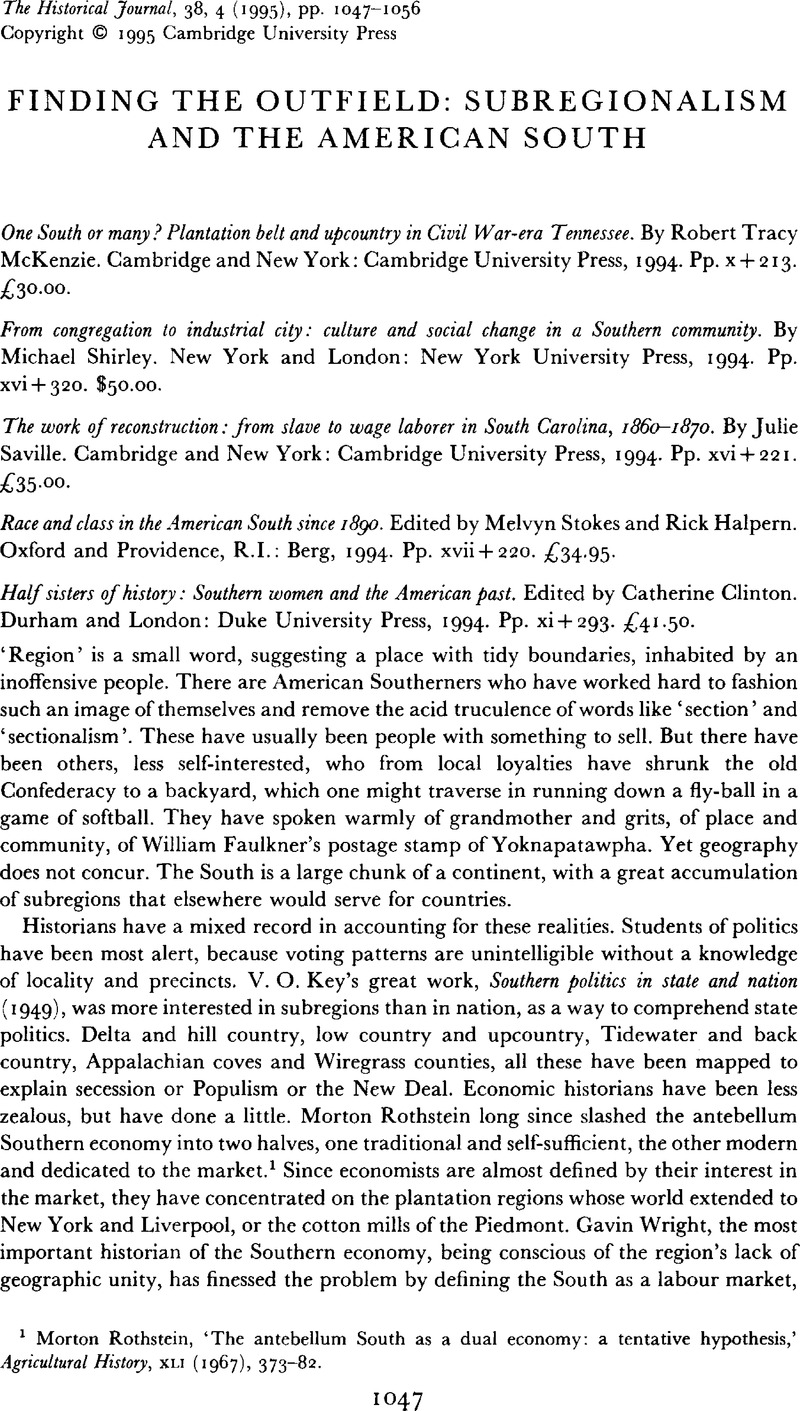Article contents
Finding the outfield: subregionalism and the American South
Published online by Cambridge University Press: 11 February 2009
Abstract

- Type
- Review Essay
- Information
- Copyright
- Copyright © Cambridge University Press 1995
References
1 Morton, Rothstein, ‘The antebellum South as a dual economy: a tentative hypothesis,’ Agricultural History, XLI (1967), 373–82.Google Scholar
2 Gavin, Wright, Old South, new South: revolutions in the Southern economy since the Civil War (New York: Basic Books, 1986), pp. 4–10.Google Scholar
3 Cobb, James C., The most Southern place on earth: the Mississippi Delta and the roots of regional identity (New York: Oxford University Press, 1992)Google Scholar; Ford, Lacy K. Jr., Origins of Southern radicalism: the South Carolina upcountry, 1800–1860 (New York: Oxford University Press, 1988)Google Scholar; Steven, Hahn, The roots of southern populism: yeoman farmers and the transformation of the Georgia upcountry, 1850–1890 (New York: Oxford University Press, 1984).Google Scholar
4 McKenzie, p. 1.
5 Ibid. pp. 190, 191.
6 Ibid. pp. 191, 192.
7 Ibid. pp. 195, 8.
8 Shirley, pp. 12, 13.
9 Ibid. p. 32.
10 Ibid. p. 56.
11 A useful anthology of these volumes is Ira, Berlin, Fields, Barbara J., Miller, Steven F., Reidy, Joseph P., AND Rowland, Leslie S., eds., Free at last: a documentary history of slavery, freedom, and the Civil War (New York: The New Press, 1992).Google Scholar
12 Saville, pp. 6–7.
13 Betty, Wood, Women's work, men's work: the informal slave economies of lowcountry Georgia (Athens: University of Georgia Press, 1995).Google Scholar
14 Saville, pp. 112, 27–8.
15 Ibid. pp. 119, 125, 158, 179.
16 Of the others, several are good but the best are Richard King's essay about the role of intellectual history in the study of the Civil Rights movement, and Brian Ward's vignette about Nat King Cole being attacked by white supremacists at a concert in Birmingham, Alabama.
17 Alex, Lichtenstein, ‘“Through the rugged gates of the penitentiary”: convict labor and Southern coal,’Google Scholar in Stokes and Halpern, pp. 10, 18.
18 Pete, Daniel, Breaking the land: the transformation of cotton, tobacco, and rice cultures since 1880 (Urbana: University of Illinois Press, 1985).Google Scholar
19 Daniel, , ‘The legal basis of agrarian capitalism: the South since 1933’,Google Scholar in Stokes and Halpern, p. 101.
20 Rick, Halpern, ‘Organized labor, black workers, and the twentieth century South: the emerging revision’,Google Scholar in Stokes and Halpern, pp. 75–76.
21 Genovese, Eugene D., The Southern tradition: the achievement and limitations of an American conservatism (Cambridge, Mass.: Harvard University Press, 1994).Google Scholar
22 Liminality seems to be fashionable; see Ayers, Edward L. and Willis, John C., eds., The edge of the South: life in nineteenth-century Virginia (Charlottesville: University Press of Virginia, 1991).Google Scholar
23 Clinton, pp. x, 2, 1, 16.
- 1
- Cited by


